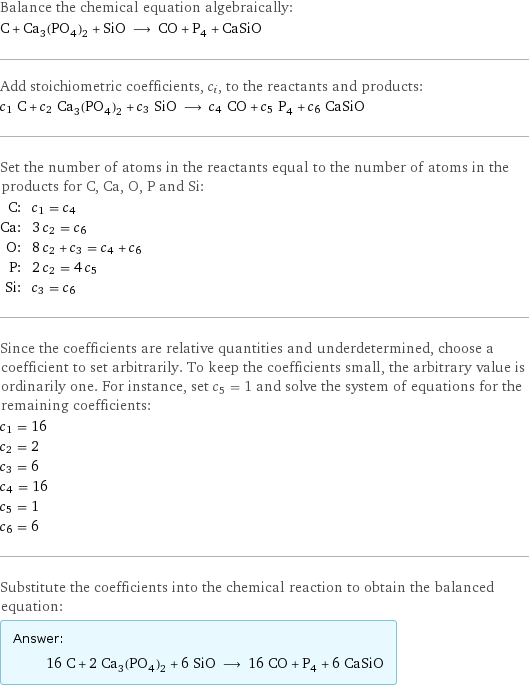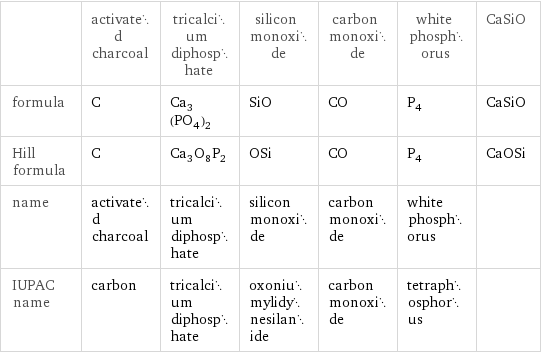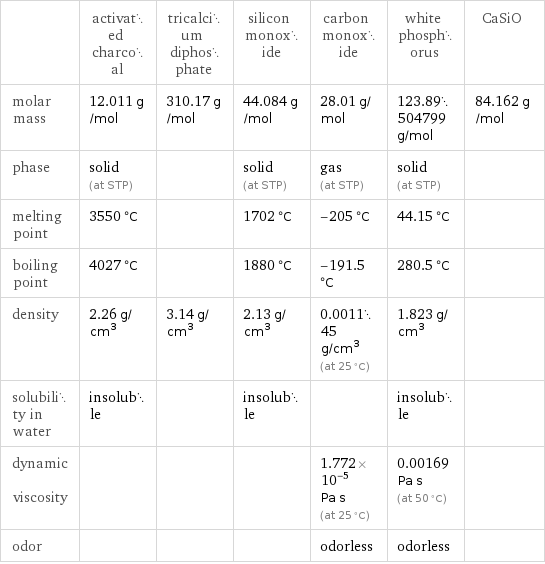Input interpretation

C activated charcoal + Ca_3(PO_4)_2 tricalcium diphosphate + SiO silicon monoxide ⟶ CO carbon monoxide + P_4 white phosphorus + CaSiO
Balanced equation

Balance the chemical equation algebraically: C + Ca_3(PO_4)_2 + SiO ⟶ CO + P_4 + CaSiO Add stoichiometric coefficients, c_i, to the reactants and products: c_1 C + c_2 Ca_3(PO_4)_2 + c_3 SiO ⟶ c_4 CO + c_5 P_4 + c_6 CaSiO Set the number of atoms in the reactants equal to the number of atoms in the products for C, Ca, O, P and Si: C: | c_1 = c_4 Ca: | 3 c_2 = c_6 O: | 8 c_2 + c_3 = c_4 + c_6 P: | 2 c_2 = 4 c_5 Si: | c_3 = c_6 Since the coefficients are relative quantities and underdetermined, choose a coefficient to set arbitrarily. To keep the coefficients small, the arbitrary value is ordinarily one. For instance, set c_5 = 1 and solve the system of equations for the remaining coefficients: c_1 = 16 c_2 = 2 c_3 = 6 c_4 = 16 c_5 = 1 c_6 = 6 Substitute the coefficients into the chemical reaction to obtain the balanced equation: Answer: | | 16 C + 2 Ca_3(PO_4)_2 + 6 SiO ⟶ 16 CO + P_4 + 6 CaSiO
Structures

+ + ⟶ + + CaSiO
Names

activated charcoal + tricalcium diphosphate + silicon monoxide ⟶ carbon monoxide + white phosphorus + CaSiO
Equilibrium constant
![K_c = ([CO]^16 [P4] [CaSiO]^6)/([C]^16 [Ca3(PO4)2]^2 [SiO]^6)](../image_source/7bda2a68cdb6568fa8b3950d6e8d2da8.png)
K_c = ([CO]^16 [P4] [CaSiO]^6)/([C]^16 [Ca3(PO4)2]^2 [SiO]^6)
Rate of reaction
![rate = -1/16 (Δ[C])/(Δt) = -1/2 (Δ[Ca3(PO4)2])/(Δt) = -1/6 (Δ[SiO])/(Δt) = 1/16 (Δ[CO])/(Δt) = (Δ[P4])/(Δt) = 1/6 (Δ[CaSiO])/(Δt) (assuming constant volume and no accumulation of intermediates or side products)](../image_source/7497088ec11a3b8d704e3351a3f2a876.png)
rate = -1/16 (Δ[C])/(Δt) = -1/2 (Δ[Ca3(PO4)2])/(Δt) = -1/6 (Δ[SiO])/(Δt) = 1/16 (Δ[CO])/(Δt) = (Δ[P4])/(Δt) = 1/6 (Δ[CaSiO])/(Δt) (assuming constant volume and no accumulation of intermediates or side products)
Chemical names and formulas

| activated charcoal | tricalcium diphosphate | silicon monoxide | carbon monoxide | white phosphorus | CaSiO formula | C | Ca_3(PO_4)_2 | SiO | CO | P_4 | CaSiO Hill formula | C | Ca_3O_8P_2 | OSi | CO | P_4 | CaOSi name | activated charcoal | tricalcium diphosphate | silicon monoxide | carbon monoxide | white phosphorus | IUPAC name | carbon | tricalcium diphosphate | oxoniumylidynesilanide | carbon monoxide | tetraphosphorus |
Substance properties

| activated charcoal | tricalcium diphosphate | silicon monoxide | carbon monoxide | white phosphorus | CaSiO molar mass | 12.011 g/mol | 310.17 g/mol | 44.084 g/mol | 28.01 g/mol | 123.89504799 g/mol | 84.162 g/mol phase | solid (at STP) | | solid (at STP) | gas (at STP) | solid (at STP) | melting point | 3550 °C | | 1702 °C | -205 °C | 44.15 °C | boiling point | 4027 °C | | 1880 °C | -191.5 °C | 280.5 °C | density | 2.26 g/cm^3 | 3.14 g/cm^3 | 2.13 g/cm^3 | 0.001145 g/cm^3 (at 25 °C) | 1.823 g/cm^3 | solubility in water | insoluble | | insoluble | | insoluble | dynamic viscosity | | | | 1.772×10^-5 Pa s (at 25 °C) | 0.00169 Pa s (at 50 °C) | odor | | | | odorless | odorless |
Units
